Serendipity in life (and) science: Christian Mellwig Inspire article
Life has a funny habit of turning out quite differently from what you expect. Take Christian Mellwig, for example. He explains to Vienna Leigh that he was determined that, whatever path he took in life, it wouldn’t be teaching.
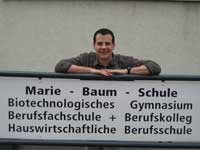
Marie Baum Schule
Image courtesy of Christian Mellwig
“My father was a teacher,” explains Christian, who for the past six years has taught chemistry, mathematics and bioinformatics to 14- to 23-year-olds at the Marie Baum Schulew1 in Heidelberg, Germany, a vocational college with an integrated biotechnology high school. “When I was a kid, he’d come home all the time with terrible stories about what had happened in his classes. I’d think, how can he enjoy his job?
“It’s not that I didn’t have a good time at school myself; I did like the chemistry and maths classes very much, because the lessons were interesting. The teachers I had at that time were very motivated, and at the same time funny and human. But nevertheless, throughout my childhood and teenage years I swore I would never become a teacher.”

Image courtesy of Michael
Schmalenstroer; image source:
Wikimedia Commons
So Christian embarked on a scientific career. He studied chemistry and mathematics at the University of Freiburgw2 and then started a PhD there, which he completed at the European Molecular Biology Laboratory (EMBL)w3 in Heidelberg in cooperation with Freiburg’s Physical Chemistry Institutew4. At this institute, researchers use physics methods to investigate biological systems. One focus is the molecules involved in photosynthesis, such as the ATP-synthase enzyme, a membrane protein. During his PhD, Christian analysed and modelled the structure of this protein using electron microscopy and three-dimensional reconstruction. So far, so good. But during his PhD, he worked at the university as a Hilfswissenschaftler, someone who helps organise and supervise the practical work of students – in this case chemistry classes for first-semester chemistry students, as well as for biology and geology students.
“I found that I really enjoyed explaining things and helping people,” he says. “I’d never had a problem talking in front of people, but I started to discover that I really actually enjoyed teaching!
“At the same time, I realised that a major part of being a scientific group leader consists of writing grant applications, papers and doing a lot of administrational work, and I could not imagine myself enjoying that kind of job. Additionally, it was very difficult for a chemist to find a position: many friends from university had finished their PhDs and did not find jobs although they were very good scientists. So I decided teaching could really be an alternative, and went through the necessary procedures. I did a Staatsexamensarbeit [a dissertation for teachers] and completed a Referendariat [a two-year vocational training that is generally required in Germany to become a teacher] at the Marie Baum Schule, and became a science teacher instead.”
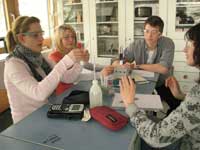
the Marie Baum Schule
Image courtesy of Christian
Mellwig
It was absolutely the right decision for Christian, although, of course, not without hurdles. “One of the biggest challenges as a teacher is to motivate the students in scientific subjects, especially chemistry and mathematics,” he says. “Very often the students tell me that their parents don’t mind if they have problems in these subjects, because the parents had the same problems themselves.
“Chemistry and mathematics are two subjects that require a lot of hard work, and I think that if a student is interested enough and willing to work hard, they can reap great rewards in these fields.”
Christian’s at a slight advantage, though, when it comes to motivating his pupils. “The students at our school are already interested in science from the beginning. In most schools, and especially in science classes, the students are clearly divided into two groups: one group which loves science, so it’s very easy for them to understand even complicated scientific ideas, and the other, which has trouble following concepts, and therefore comes to hate scientific subjects. We only really see the first group.”
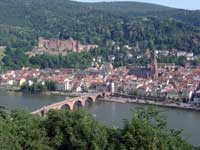
Image courtesy of Frumpy;
image source: Wikimedia Commons
In Germany, the school system differs slightly from one federal state to another. In Baden-Württemberg, students at the age of 16 who decide to pursue the three-year qualification for university have four school types with different profiles to choose from: the economics high school (Wirtschaftsgymnasium), the nutritional science high school (ernährungswissenschaftliches Gymnasium), the technical high school (technisches Gymnasium) and the biotechnology high school (biotechnologisches Gymnasium). Biotechnology high schools also exist in the federal states of Bavaria and Saxonia.
In Baden-Württemberg, they cover a wide range of science subjects: biotechnology (six lessons a week, one of them in the form of practical work in professionally equipped laboratories), bioinformatics (two lessons a week), physics and more chemistry lessons than in other school types. In addition, there are special subjects within life sciences (‘Sondergebiete der Biowissenschaften’) covering topics like nutritional studies, nanochemistry or bionics, in which labwork is very important.
Christian and his colleagues also motivate their students to take part in the International Biology and Chemistry Olympiadsw5, and one of their students even won a silver medal for Germany at the International Biology Olympiad in Argentina in 2006. This is why the Marie Baum Schule has a sterling success rate for turning out scientists. “Roughly half of our students choose a science career, mainly in biology, medicine, chemistry or molecular biology,” says Christian. “Due to their education they have a fantastic starting point for university and are interesting candidates for a range of companies.
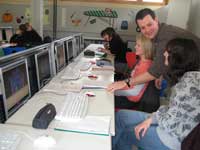
at the Marie Baum Schule
Image courtesy of Christian Mellwig
“To try to keep in contact with as many of them as possible, I’ve established a web platform on our school homepage where the alumni can register.
From time to time we meet at the school, and some of them tell me that the notes they made during my lessons are very useful and they still use them at university. They also send me emails asking for advice when they have problems in chemistry!” And sometimes, they make Christian proud: “Recently, I got an email from an overjoyed student who had received one of only 23 positions at the Heidelberg German Cancer Research Centre (DKFZ)w6 – out of 2000 applicants!”
Despite the success rate, though, Christian has several ideas about how science teaching in schools can be developed and improved on a general basis. “I think it’s very important for children to meet ‘real’ scientists and talk to them to get ideas of what kind of options there are with a science background,” he says. “Some of my students visited EMBL, where I did my PhD, and they were very surprised, because they didn’t expect scientists to be like everyday people, with hobbies and other interests!
“I didn’t have the chance to meet a scientist when I was at school; the first time I met one was when I started at university. For me, for a long time, all scientists just looked like Albert Einstein!”
In the classroom, though, Christian can’t emphasise enough the importance of practical sessions. “Practical work is the only way to get children and students excited about science,” he says. “It takes up a lot of time, and so many teachers have doubts about whether all their efforts are worth it. But the practical work is a major part of my lessons because I believe every theoretical concept should be backed up with experiments.”
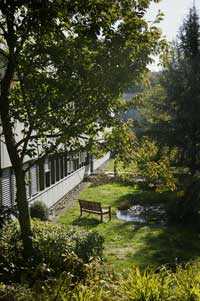
Image courtesy of EMBL Photolab
Christian gets his ideas from various sources, and recently picked up some useful inspiration at a teacher-training course. “The chemistry retraining was about automatic data recording during chemical experiments. We were able to learn how to handle the machines by ourselves and try out some experiments. I feel I learn more if I have ‘hands-on’ training rather than listening to someone explain how these machines work, and it’s the same for my students: information stays with them longer than if they’re just listening to me standing in front of them talking.
“When I was at school, ‘chalk and talk’ was the most usual teaching method, but nowadays schools are also more keen for children to work on projects in teams and learn new topics by self-organisation, so every student is able to learn at his or her own speed. This makes it easier for me, the teacher, because I can help the students individually – and it gives me a break from being the centre of attention!”
Despite his own decision to leave research, Christian always encourages those students who choose to follow a scientific path. “It’s a fascinating thing. For me, science was always like a puzzle, where you try to find out which pieces belong together. Of course, you normally only work on one little piece, but to find some new information about the whole puzzle is hugely exciting.
“One day from my scientific career that will stay with me forever was a day when I did something absolutely wrong – or so I thought – and the result I got was one I had been waiting a whole year for. I was trying to get a three-dimensional structure of ATP synthase using electron microscopy, but my samples never contained the enzyme. The problem was obvious to me, but not the solution: I always used detergent to embed the samples, since I thought that membrane proteins – such as ATP synthase – needed this to stay soluble.
On the other hand, every student knows that detergent destroys the surface tension of water. But this surface tension would have been required to get a thin layer of vitrified water, a form of ice in which the water molecules are arranged exactly as in liquid water, rather than forming crystal structures as in normal ice. The formation of ice crystals can destroy the structure of the proteins you are trying to analyse, so vitrification is essential. Then one day I accidentally forgot to add the detergent – and the enzymes were embedded nicely. I think I never would have made it as far as I did without that accidental discovery, and that’s the fantastic thing about science.”
Web References
- w1 – The website of Marie Baum Schule can be found here: www.mbs-hd.de
- w2 – For more information on Freiburg University, see: www.uni-freiburg.de/index_en.php
- w3 – For more information on the European Molecular Biology Laboratory, see: www.embl.org
- w4 – To find out more about the Physical Chemistry Institute at Freiburg University, see: www.physchem.uni-freiburg.de
- w5 – For more information on the International Biology Olympiad, see: www.ibo-info.org
- For more information on the International Chemistry Olympiad, see the websites of the 2008 edition: http://icho.hu/pages/Home.aspx
- w6 – The website of the German Cancer Research Centre Heidelberg (DKFZ) can be found here: www.dkfz.de
Resources
- Christian’s PhD work on the structure of ATP synthase (in German) can be found here: www.freidok.uni-freiburg.de/volltexte/560
- Mellwig C, Böttcher B (2003) A unique resting position of the ATP-synthase from chloroplasts. Journal of Biological Chemistry 278(20): 18544-18549. www.jbc.org/cgi/content/full/278/20/18544
Institutions
Review
This article can be used in teacher-training classes to prompt discussion about scientists becoming teachers. It could also start teachers thinking about how students perceive scientists; they could ask students to draw or describe scientists.
The article could also be given to students in a science class when looking at different career options. It helps to show that there are many diverse paths a scientist can follow, and that teaching may be one of those paths.
Shaista Shirazi, UK





